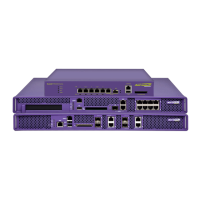Network Setup
Summit WM3000 Series Controller System Reference Guide214
4 When using clustering and the Cluster GUI feature is enabled, a drop-down menu will be available
to select which cluster members’ APs are displayed. To view APs from all cluster members, select All
from the drop-down menu. To view APs radios from a specific cluster member, select that member’s
IP address from the drop-down menu.
5 Click the Export button to export the contents of the table to a Comma Separated Values file (CSV).
Viewing Unadopted Access Points
Use the Unadopted AP tab for gathering device hardware address and software version information for
the Access Point.
To view existing Radio Configuration information:
1 Select Network > Access Point from the main menu tree.
2 Click the Unadopted AP tab.
The Unadopted AP tab displays the following information:
3 Select an available index and click the Adopt button (at the bottom of the screen) to display a screen
wherein the properties of a new radio can be added for adoption to the controller. When displayed,
the screen prompts for the MAC address and type of radio. Complete the fields and click the OK
button to add the radio.
4 Click the Export button (at the bottom of the screen) to export the contents of the table to a Comma
Separated Values file (CSV).
Index
Displays a numerical identifier used to associate a particular Access Point
with a set of statistics and can help differentiate the Access Point from
other Access Points with similar attributes.
MAC Address
Displays the unique Hardware or
Media Access Control
(MAC) address for
the Access Point. Access points with dual radios will have a unique MAC
address for each radio. The MAC address is hard coded at the factory and
cannot be modified.
Last Seen (In
Seconds)
Displays the time the Access Point was last seen (observed within the
controller managed network). This value is expressed in seconds. Use this
value to assess if the Access Point is no longer in communications with
the controller.

